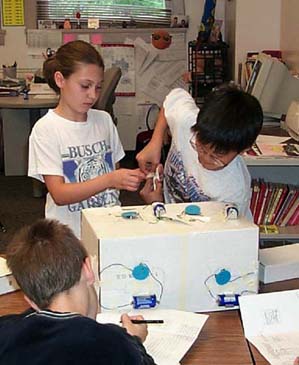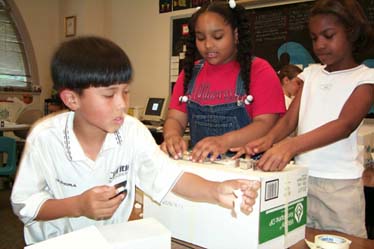( BACK TO POSTER )
Original goals for project sustainability under ideal conditions
Convert to an activity-inquiry science program in Grades K-5
- Implement an activity-inquiry curriculum
- Use inquiry-based teaching and learning strategies
- Guide instruction with authentic assessment
- Involve scientists and engineers
2. Cooperate with a university partner and expand the Teacher Enhancement and Materials Management Center at Tennessee State University
- Provide kits and materials for all modules as needed in classrooms
- Provide and facilitate on-going professional development of teachers and principals
- Assist in curriculum planning
- Conduct research and evaluation
In the best of all possible worlds:
- A comprehensive professional plan would be established to drive continuous improvement and commitment to reform. The plan would link PD to instruction that would be planned to address evidence from multiple measures that are aligned with curriculum, materials and assessment!
- Students and teachers would know benchmarks of knowledge, skills, and processes and progress would be made on a seamless pathway for all students!
- Sustained change would reflect what we know about effective learning and teaching!

( BACK TO POSTER | BACK TO TOP )
Reflections on these goals from the end of the project funding cycle
Sustainability - the Elusive Goal
Introduction: Many lessons could be shared about sustainability and much remains to be learned. I have tried to share lessons that could reasonably be generalized across multiple sites. However, the lessons are somewhat specific to the unique context of our complex urban systemic change locale. Therefore, I hope the lessons shared will be viewed not as absolutes, but starting points for considering the relationship between sustainability and continuous improvement. Organizationally, I have attempted to group various sustainability lessons and issues with some of the critical drivers of reform. The drivers are also interrelated.
The most important lesson is that our efforts to improve science education and promote scientific literacy must be based on current and evolving knowledge in many disciplines and best practice in teaching and learning.
Lessons Learned: Reflections on Reform Drivers
Driver 1.
Implementation of a comprehensive, standards-based curriculum (and instructional materials) that is aligned with instruction and assessment available to every student served by the school district.
Implementing and sustaining the curriculum is dependent on teachers buy-in in terms of their beliefs about what is good for children (and what will be assessed). To gain and sustain this buy-in is essential.
- on-going group process for standards-based curriculum selection and in-depth PD on curriculum selection process
- on-going analysis that demonstrates the relationship between curriculum, instruction and assessment.
Driver 2.
Development of a coherent, consistent set of policies that supports provision of broad-based reform of science education K-12.
The district's (or consortium of districts) strategic plan must incorporate a comprehensive PD approach that is consistent with the continuous improvement process. It has to be multi-year and address clearly the progression of enhancement to move teachers from novice to competent to expert. This PD plan and the policies to implement it are as essential as the standards-based curriculum is for the students. The clear picture of what teachers will be able to do based on PD (benchmarks of practice) should guide the plan, so the beliefs about what is good for children drives the buy in to the plan. Policies about PD leave and strategies for school-wide implementation are crucial. The PD plan needs to be linked to achievement data.
Driver 3. Convergence of all resources that are designed for or that reasonably could be used to support science or math education - fiscal, intellectual, material - both in formal and informal education settings - to upgrade and continually improve the educational program for all students.
- Fiscal - Budget planning must be multi-year
- Intellectual-Teacher leadership, key staff developers and external resources
- Materials - Broad-based view of education vs. schooling that focuses on learning not teaching
Driver 4. Broad-based support from parents, policymakers, institutions of higher education, business and industry, foundations, and other segments of the community.
Catalysts for change external to the district's resource are needed to provide feedback about change and to support districts to stay the course of change by maintaining the fidelity of implementation of the standards-based curriculum, instruction, assessment, and comprehensive PD plan.
Driver 5. Accumulation of a broad and deep array of evidence that the initiative is enhancing student achievement through a set of indices (e.g., achievement test scores, higher level courses passed, advanced placement tests taken, college admission rates, college majors, portfolio assessment, research experiences, ratings from summer employers).
The reform effort may or may not be sustained even though evidence exists. However, the broader the base of evidence the greater the likelihood the change will undergo continuous examination and reinvention/continuous improvement.
Driver 6. Improvement in the achievement of all students including those historically underserved as evidenced by progressive increments in student performance.
Various constituencies will want evidence of the importance of the change and the outcome. Evidence of change in science and mathematics education needs to be linked to the broader goals of schooling and society.

( BACK TO POSTER | BACK TO TOP )
Suggestions for projects starting out; or, how we might have done things differently
- Establish a comprehensive staff development plan. For example this would include enhancement on the science program at the beginning of the year for all new principals. We did not have the training for principals at the beginning of the year during our first two years. Our new principal training was done in the spring. Brand new principals need to receive an orientation to the new curriculum/inquiry based teaching, change management, and how to observe for standards-based instruction as soon as they become principals. This helps them to understand the importance of their role in moving the reform forward. Also, this lends support for teacher release to attend training.
- Conduct a policy audit to see how all policies effect the implementation of a comprehensive, standards-based, long-term reform. Sometimes, problems of conflicting policies can be addressed early.
- Collect systematic training data and provide this to principals at quarterly meetings.
- Include principals in training recognition events and recognize their leadership.
- Work directly with principals in the selection of school facilitators and the criteria that needs to be followed in choosing facilitators.
- Make the school the unit of change that is desirable. This supports sustainability.
( BACK TO POSTER | BACK TO TOP )
Questions for other project's staff to reply to
- How can districts be facilitated to realign resources to promote and sustain change?
- What strategies can be used to sustain key elements of change, such as teacher buy-in to new curriculum?
- What budget strategies result in LSC projects' lead teachers being kept as the districts' leaders of on-going professional development?
THIS POSTER WAS PREPARED BY:
Barbara A. Nye of the Metro-Nashville
NSF-LSC Elementary Science Project.
( BACK TO POSTER | BACK TO TOP )


